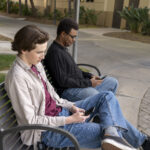Several students and faculty members of the Gordon and Jill Bourns College of Engineering are continuing their research that started over the summer on the effects and potential prevention techniques of glaucoma.
The permanent loss of eyesight caused by glaucoma heightens the importance of their studies. Because of the irreversible effect, they are developing a device and system that detects early signs of glaucoma that can aid in prevention of the disease progressing.
Through their research, the California Baptist University Glaucoma Sensor Project discovered pressure within the human eye varies throughout the day and the pressure relates to and affects the amount in which the eye stretches daily.
Joshua Park, senior biomedical engineering major, is one of the students working on the research and development of the device.
“Our device works by recording very small veins next to the cornea and observes them stretching,” Park said.
Designed to be small enough to fit inside a pair of eyeglasses and accurately record changes in the wearer’s eyes, Dr. Matthew Rickard, chair of the BioEngineering Department and associate professor of bioengineering, said he believes the device has the potential to make a difference.
“The system will provide the patient, clinicians and social support groups with real-time, mobile ocular health data,” Rickard said. “(The system) will support and initiate new scientific and clinical research related to mobile ocular health and increase public awareness of glaucoma.”
Although diagnosing the subtle signs of glaucoma in its early stages and how to prevent it is difficult, the team has found a way to relay information to the public in a more efficient way. Their device uses an app installed on the wearer’s phone where information is provided in real time.
“The end goal of the glaucoma research is to create a system that can analyze images taken of the eye to determine the pressure in the eye which is then used to determine if the subject has glaucoma or is at risk for it,” said Emily Sutter, junior biomedical engineering major.
With the end goal of creating a system to analyze images taken of the eye to determine the pressure and possible risk or diagnosis of glaucoma, Sutter said she ensures the CBU engineering students and faculty are best fit for the challenge.
“Engineers can provide a unique problem-solving perspective,” Sutter said. “In addition to researching glaucoma to learn more about it, engineers also continuously look for new and improved ways of detecting and preventing glaucoma.”
The team is dedicated to improving their device to be wearable, functional and accurate for a chance at combating the damage of the disease.


